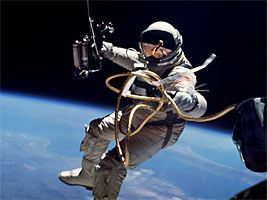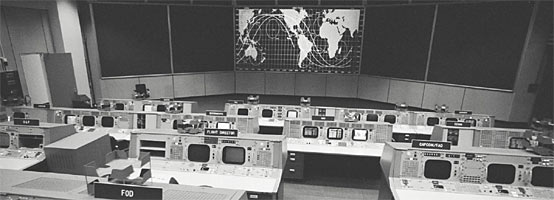
Astronaut Edward H. White II, pilot of the
Gemini IV space mission, is photographed during his
extravehicular activity, the first ever by an American.
The photo was taken in June 1965. |
|
Liftoff from
Launch Complex 19 at Cape Kennedy was at 10:16 a.m. EST June
3, 1965, and flight trajectory was very nearly as planned. The
spacecraft with astronauts James A. McDivitt as command pilot
and Edward H. White II as pilot was placed in an orbit with a
perigee of 100 miles and an apogee of 175 miles.
Gemini
IV, with McDivitt and White aboard, landed about 48 miles
short of the intended target, the USS Wasp, at 11:12 a.m.,
Houston time, June 7, after making 62 revolutions of the Earth
in 97 hours and 56 minutes. Both crewmembers were in fine
shape and were returned to the Wasp by helicopter.
For the
first time, flight controllers performed their jobs from the
new Mission Control Center at the Manned Spacecraft Center.
Gemini IV became the first flight controlled from Houston and
the longest duration mission to that date. The Cape Kennedy
control center provided backup services for the initial launch
and trajectory, and Goddard Space Flight Center's computer
center provided support for the entire four-day mission. GSFC
was the communications center. The computers were in the new
MCC for the first time.
This
flight established JSC as the nation's home for Mission
Control. But this responsibility could have easily gone to
Goddard Space Flight Center or to the Kennedy Space Center
and, had it, JSC would not be the nerve center for space
shuttle and International Space Station flight control
operations that it is today.

An overall view of the Mission
Operations Control Room on the second floor of NASA's Houston
Mission Control Center. The space shuttle orbiter spotter or
symbol can be seen in the center of the tracking map on the
large screen in the front.
The
concept of a ground-based flight control team to manage human
space missions was implemented from the beginning of Mercury.
Flight control remains a key element of the mission planning
process. For the most part, program offices delineate mission
activities and objectives. With its vast expertise, the flight
control team uses spacecraft and space station systems to
accomplish mission objectives and to monitor the status of
flights as they occur.
As
Mercury began orbital missions with John Glenn's flight on
Feb. 20, 1962, equipment and procedures needed to be updated.
And when Gemini came on line, the system established for the
Mercury Program also had to be created. The Mercury control
center at Cape Canaveral used commercial off-the-shelf
electronics gear, but more was needed. It became obvious that
existing equipment was inadequate. A study of the needs and
options for a new mission control center was
begun. |





